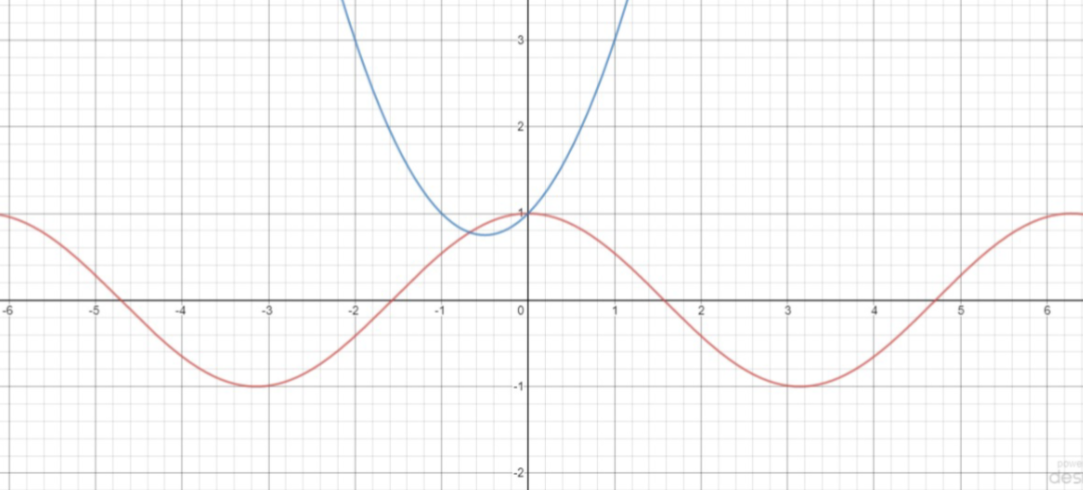
The number of real solutions of the equation $\cos x = {x^2} + x + 1$ is
A. 2
B. 1
C. 0
D. None of these
Answer
573.9k+ views
Hint – In this question, we will proceed by solving the RHS part of the given equation by a complete square method. Then plot a graph between them to know whether they are interesting or not. Then we can find the number of real solutions to the given equation.
Complete step-by-step solution -
Given equation is \[\cos x = {x^2} + x + 1........................\left( 1 \right)\]
Now we will solve equation (1) by completing square method where we will divide and multiply the coefficient of \[x\] with ‘2’
\[ \Rightarrow \cos x = {x^2} + 2 \times \dfrac{x}{2} + 1\]
We can write ‘1’ as \[\dfrac{1}{4} + \dfrac{3}{4}\]. So, we have
\[
\Rightarrow \cos x = {x^2} + 2 \times \dfrac{x}{2} + \dfrac{1}{4} + \dfrac{3}{4} \\
\Rightarrow \cos x = {x^2} + 2\left( x \right)\left( {\dfrac{1}{2}} \right) + \dfrac{1}{{{2^2}}} + \dfrac{3}{4} \\
\]
Using the algebraic identity \[{a^2} + 2ab + {b^2} = {\left( {a + b} \right)^2}\], we have
\[\therefore \cos x = {\left( {x + \dfrac{1}{2}} \right)^2} + \dfrac{3}{4}\]
When we plot a graph between \[y = {\left( {x + \dfrac{1}{2}} \right)^2} + \dfrac{3}{4}\] and \[y = \cos x\] we have the graph as

So clearly, they are intersecting at two points.
Hence there are two real solutions to given equation \[\cos x = {x^2} + x + 1\].
Thus, the correct option is A. 2
Note – These kinds of questions must be solved with full concentration and practiced as many times as you can make the mistake in the method used, i.e., Completing the Square Method, which is very confusing as we keep multiplying and dividing different terms with the equation.
Complete step-by-step solution -
Given equation is \[\cos x = {x^2} + x + 1........................\left( 1 \right)\]
Now we will solve equation (1) by completing square method where we will divide and multiply the coefficient of \[x\] with ‘2’
\[ \Rightarrow \cos x = {x^2} + 2 \times \dfrac{x}{2} + 1\]
We can write ‘1’ as \[\dfrac{1}{4} + \dfrac{3}{4}\]. So, we have
\[
\Rightarrow \cos x = {x^2} + 2 \times \dfrac{x}{2} + \dfrac{1}{4} + \dfrac{3}{4} \\
\Rightarrow \cos x = {x^2} + 2\left( x \right)\left( {\dfrac{1}{2}} \right) + \dfrac{1}{{{2^2}}} + \dfrac{3}{4} \\
\]
Using the algebraic identity \[{a^2} + 2ab + {b^2} = {\left( {a + b} \right)^2}\], we have
\[\therefore \cos x = {\left( {x + \dfrac{1}{2}} \right)^2} + \dfrac{3}{4}\]
When we plot a graph between \[y = {\left( {x + \dfrac{1}{2}} \right)^2} + \dfrac{3}{4}\] and \[y = \cos x\] we have the graph as

So clearly, they are intersecting at two points.
Hence there are two real solutions to given equation \[\cos x = {x^2} + x + 1\].
Thus, the correct option is A. 2
Note – These kinds of questions must be solved with full concentration and practiced as many times as you can make the mistake in the method used, i.e., Completing the Square Method, which is very confusing as we keep multiplying and dividing different terms with the equation.
Recently Updated Pages
Master Class 11 Business Studies: Engaging Questions & Answers for Success

Master Class 11 Computer Science: Engaging Questions & Answers for Success

Master Class 11 Maths: Engaging Questions & Answers for Success

Master Class 11 Chemistry: Engaging Questions & Answers for Success

Master Class 11 Economics: Engaging Questions & Answers for Success

Master Class 11 Accountancy: Engaging Questions & Answers for Success

Trending doubts
What is meant by exothermic and endothermic reactions class 11 chemistry CBSE

10 examples of friction in our daily life

One Metric ton is equal to kg A 10000 B 1000 C 100 class 11 physics CBSE

1 Quintal is equal to a 110 kg b 10 kg c 100kg d 1000 class 11 physics CBSE

Difference Between Prokaryotic Cells and Eukaryotic Cells

What are Quantum numbers Explain the quantum number class 11 chemistry CBSE




